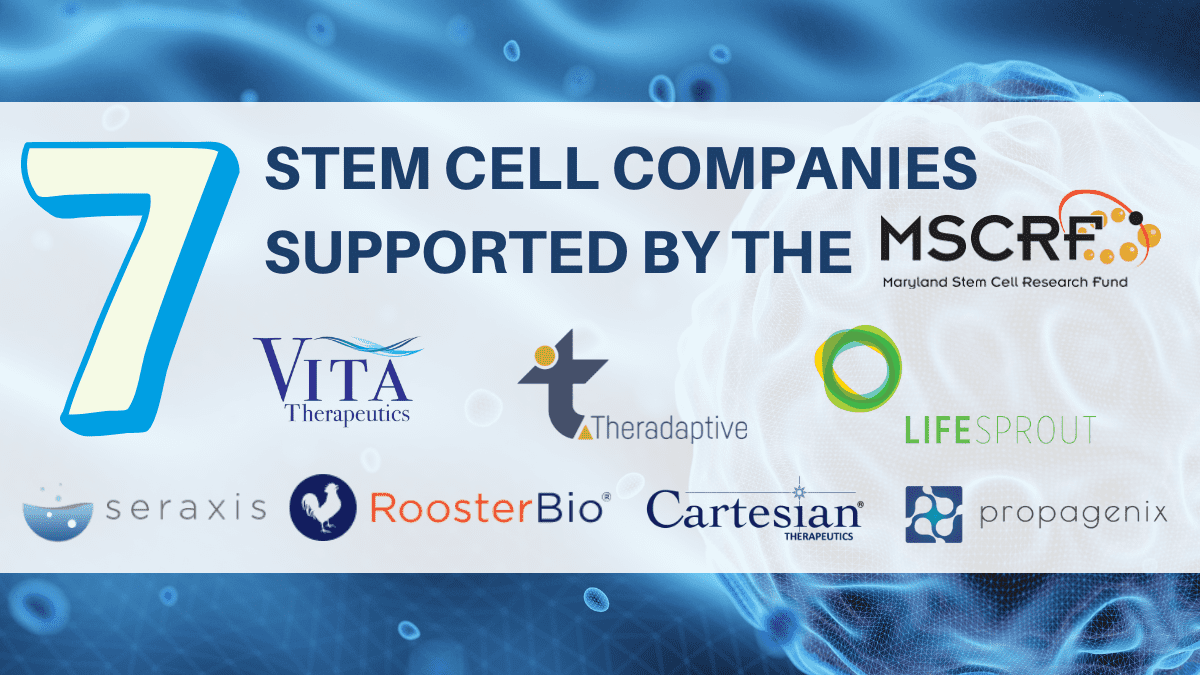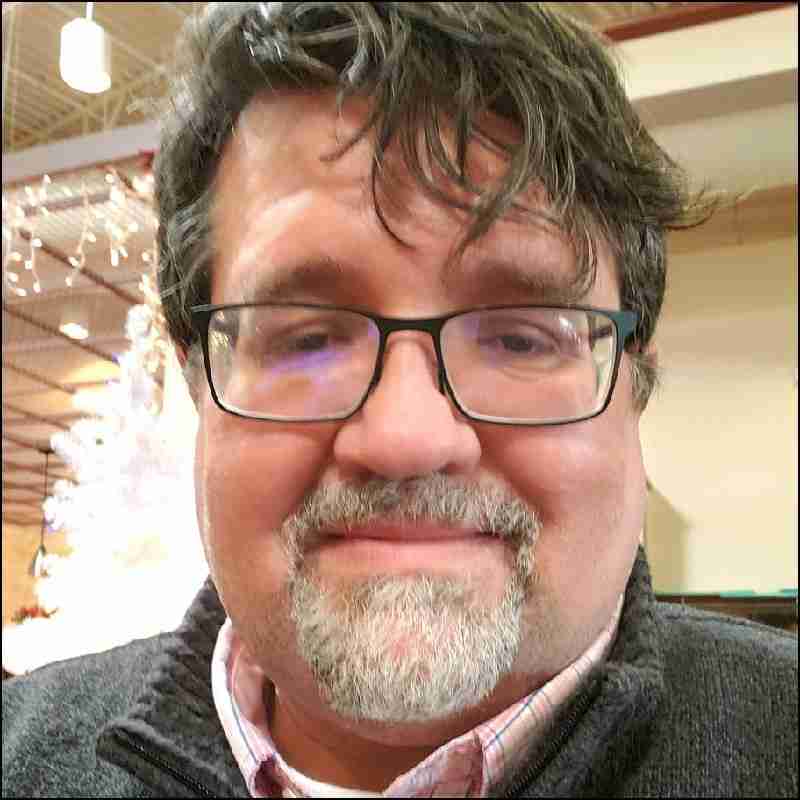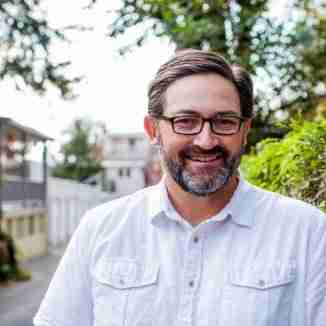
Top Stem Cell Companies Supported by the Maryland Stem Cell Research Fund
Updated 9/1/22
The State of Maryland made a visionary investment in regenerative medicine when it created the Maryland Stem Cell Research Fund (MSCRF) in 2006. The fund provides financial support to public and private organizations developing promising stem cell-based treatments and technologies in the State.
Since its inception, MSCRF has invested over $170 million in over 500 projects to accelerate stem cell research, commercialization, and cures. With a 2023 fiscal year budget of $20.5M, MSCRF offers six funding opportunities to scientists and companies in the areas of clinical trials, discovery, commercialization, validation, launch, and post-doctoral fellowships. The fund has supported the creation and growth of many stem cell companies since launching the Accelerating Cures initiative in 2017.
Dr. Amritha Jaishankar leads MSCRF’s programs and identifies unmet medical needs and the portfolio companies that can solve them. “I’m incredibly proud that our efforts have supported the creation and/or growth of companies developing promising treatments and cures for a wide-range of medical conditions,” said Executive Director Dr. Jaishankar. “In the past 5 years, we’ve awarded 26 research/product development and/or clinical trial grants to companies that are advancing regenerative medicine research. We have helped them de-risk technologies, create value, and reach critical milestones through our various funding programs.”
BioBuzz has reported on and/or highlighted many Maryland-based companies that have received financial support from the Fund and recognized them as important, emerging life sciences companies in the region. Here are seven of them that are pushing the boundaries of stem cell research.
Vita Therapeutics
Founded in 2019, Vita Therapeutics is developing induced pluripotent stem cell (iPSC) technology to engineer specific cell types designed to replace those that are defective in patients. The company recently expanded its headquarters and secured 10,000 square feet of leased space in Baltimore’s BioPark to bring the company’s entire team under one roof as it looks to advance the co-lead programs of VTA-100 and VTA-300.
VTA-100 and VTA-300 are being developed for the treatment of limb-girdle muscular dystrophy (LGMD) and multiple solid tumors, respectively. The company hopes to take both assets into the clinic in 2023. The idea for VTA-100 is to use induced pluripotent stem cells to derive genetically corrected satellite cells and inject them straight into the muscle mass that is affected by the disease.
In the long term, the company intends to follow a dual development strategy that will begin with autologous-derived cells before moving to a universal hypoimmunogenic cell line.
In 2021, it secured $32 million in an oversubscribed Series A financing round. The financing will support the advancement of the company’s lead programs, as well as the development VTA-200, which is a genetically engineered iPSC-derived hypoimmunogenic treatment designed to treat multiple types of muscular dystrophy.
Theradaptive
Frederick, Maryland-based Theradaptive has been on a roll this year with its regenerative medicine platform. Over the past 12 months, the company has secured three breakthrough designations from the U.S. Food and Drug Administration for its spinal fusion assets.
Theradaptive is developing a new class of regenerative implants bolstered by its computational platform that converts recombinant proteins into material-binding variants capable of coating implants and other medical devices. This process allows the company to deliver therapeutics to any location in the body with precision. As of 2022 there are no precision regenerative implants available to treat spinal fusion, orthopedic repair, or craniomaxillofacial repair, according to Theradaptive.
This year, the company’s OsteoAdapt SP in Anterior Lumbar Interbody Fusion has picked up multiple breakthrough designations from the FDA. Most recently, OsteoAdapt SP earned Breakthrough Medical Device designation in June. The FDA’s Breakthrough Devices Program supports select medical devices that provides for more effective treatment or diagnosis of life-threatening or irreversibly debilitating diseases or conditions. Theradaptive gains priority review for OsteoAdapt SP.
The latest award is the third for OsteoAdapt SP. In February 2022, Theradaptive won Breakthrough Medical Device designation for its OsteoAdapt SP Spinal Fusion implant indicated for posterolateral spinal fusion to treat degenerative disc disease, spondylolisthesis, or retrolisthesis. With its other assets for transforaminal interbody and posterolateral fusion, Theradaptive has said that it is able to address more than 90% of lumbar spinal fusion procedures.
Theradaptive, which was spun out of the Massachusetts Institute of Technology, earned the first designation in late 2021. The company’s approach was driven by the needs for better treatment options for U.S. military service men and women who have been injured in combat. Theradaptive has received significant research and development support from the US Department of Defense. In all, Theradaptive’s platform has multiple applications, including spinal fusion, soft tissue repair, local therapeutic delivery tissue patches, trauma repair, dental repair, and complex cartilage repair.
In addition to its implants, Theradaptive is also developing AMP2, a “bone paint” that has been designed to regrow bone in gaps at least two inches long. If the technology passes clinical muster, it could provide more targeted and controlled approaches to re-growing bone than current technologies.
Seraxis
Located in Germantown, privately-held Seraxis launched in 2013. The company is focused on developing cell replacement therapy for insulin-dependent diabetes patients. The company’s lead asset is SR-01, which is being developed to eliminate the need for type 1 diabetes patients to inject insulin. The Seraxis approach to diabetes treatment seeks to replace damaged or lost insulin-producing pancreatic cells with those grown in the company’s labs. Seraxis is currently preparing an Investigational New Drug Application for SR-01 and could be in the clinic with its asset in 2023.
Seraxis’ clinical program is based on its proprietary human stem cell line dubbed SR1423. When coupled with Seraxis’ manufacturing process, the cells mature into lab-grown pancreatic islets that mimic native islets in purity and potency. Islets are clusters of hormone-secreting cells within the pancreas. The hormones generated by the islets, such as insulin and glucagon, allow the body to maintain a healthy level of glucose in the blood. These islets are damaged or non-existent in diabetes patients. Seraxis’s islets have shown the potential to reverse diabetes in preclinical animal models.
This year, the company moved into a new facility in Montgomery County, which triples the company’s previous space in the Germantown Innovation Center (GIC) at Pinkney Innovation Complex for Science & Technology at Montgomery College (PIC MC). The move followed a financial shot in the arm in late 2021. Seraxis closed a $40 million Series C financing round that provided it with funds to support its move, as well as its clinical programs.
RoosterBio
Frederick-based RoosterBio, a privately held cell manufacturing platform technology company, develops high-volume and well-characterized adult human mesenchymal stem/stromal cells (hMSCs) that are paired with highly engineered media systems. The company is focused on accelerating hMSC and extracellular vesicle (EV) product and process development in order to fuel the rapid commercialization of scalable regenerative cures.
RELATED: Maryland Stem Cell Research Fund Supports Innovative Women Researchers, Part 1
The company has forged several collaborations, including the recent partnership with Seattle’s AGC Biologics to manufacture cell and exosome therapies. Under terms of the deal, RoosterBio will use its portfolio of cell and media products to develop robust, scalable processes for hMSC and exosome therapies. In their announcement, RoosterBio and AGC said the partnership will create an “end-to-end solution for the development and production of hMSC and exosome therapeutics” that will be paired with AGC Biologics’ global cell and gene therapy manufacturing capabilities. Earlier this year, ShiftBio struck a deal with RoosterBio in order to accelerate the development of its asset SBI-102 (Stem cell-derived exosomes expressing a therapeutic ligand) into the clinic.
In addition to the development of stem cells, RoosterBio has also made a mark of a different kind. The company jumped into the art of non-fungible tokens (NFTs) as part of its marketing strategy.
Cartesian Therapeutics
Gaithersburg-based Cartesian Therapeutics started out 2022 dosing its first patient with Descartes-25, which the company called the first off-the-shelf RNA cell therapy to enter a clinical trial in oncology. Descartes-25 is being assessed in a Phase 1/I2a study in multiple myeloma. Cartesian Therapeutics developed Descartes-25 from its proprietary RNA Armory cell manufacturing platform, which includes a cell bank of human umbilical cord mesenchymal stem cells.
Cartesian Therapeutics manufactures its stem cell products at its state-of-the-art cGMP manufacturing facility in Gaithersburg. This enabled complete control of product quality, production schedules and costs while accelerating clinical translation of discoveries, the company said.
In addition to Descartes-25, the company is also developing Descartes-08 for Myasthenia Gravis, which has been billed as the first RNA cell therapy in the clinic for autoimmune disease, and Descartes-11 for multiple myeloma.
In May 2022, the company was named Emerging Life Science Company of the Year by the Maryland Tech Council.
LifeSprout
LifeSprout, founded in 2015, is a spinout company produced by the Johns Hopkins Technology Ventures’ (JHTV) FastForward incubator program. Dr. Sashank Reddy, a former JHU Hodson Scholar, founded LifeSprout on technology licensed out of Johns Hopkins. Reddy also serves as JHTV’s Medical Director and is still a key part of the LifeSprout team, which is led by Executive Chairman Adam Gridley.
The company’s Regenerative Matrix (RM) platform, which consists of chemically-defined, biocompatible materials with a natural feel that can integrate with living cells. RM products look and feel like natural tissue and mimic the extracellular matrix, all without animal or cell-derived constituents. The company is currently focused on developing aesthetic and regenerative medicine applications from this platform, including products for soft tissue loss, a major issue caused by cancer surgery, congenital malformations, and the aging process.
RELATED: TEDCO 2021 Recap – Successful Initiatives and New Funding Programs
LifeSprout’s lead product candidate, a dermal filler called Lumina that was created via the RM technology, is a regenerative dermal filler that feels more like native tissue. The dermal filler sector is a $2B market that was growing about 10% a year prior to the pandemic. The second prong of the company’s strategy is using the RM platform in the cell therapy space. During RM platform testing, LifeSprout discovered that its technology has the potential to augment cell therapy, where in many cases cells transferred into the body die, diffuse, or don’t get incorporated.
LifeSprout’s most recent milestone was closing on a $28.5M Series A funding round.
Propagenix
Based in Gaithersburg, Propagenix is quietly developing technology that will provide engineered tissue solutions to address clinical needs for the replacement of a patient’s dysfunctional or damaged barrier tissues. The company’s technology aims to expand and differentiate tissue-resident epithelial stem cells from tissues such as skin, airway, kidney, and cornea.
Using its EpiX technology platform, Propagenix is capable of providing a “trillion-fold expansion of human keratinocyte stem cells.” The company said the limited number of primary keratinocytes isolated from a pea-sized skin punch biopsy can be expanded into hundreds of billions of keratinocytes in order to produce skin sheets that cover several square meters, more than enough to cover a human adult. An adult’s total skin area is about 2 square meters, Propagenix notes on its website.
The company has also developed a bi-layered skin structure that includes both dermal and epidermal layers. The structure “recapitulates normal skin architecture” that includes what Propagenix calls a robust basal stem cell population. Now, with this technology, the company aims to produce a clinically-ready form of the engineered skin grafts.
Many of these founders were featured at the International Society for Stem Cell Research (ISSCR) annual meeting during MSCRF’s focus session. Watch more here:






